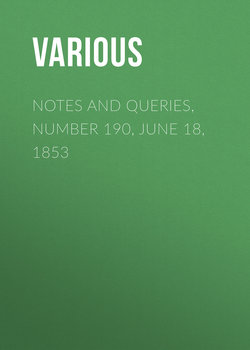Читать книгу Notes and Queries, Number 190, June 18, 1853 - Various - Страница 9
Minor Queries
Оглавление"Seductor Succo."—Will any of your readers oblige me by giving me either a literal or poetical translation of the following lines, taken from Foulis, Rom. Treasons, Preface, p. 28., 1681?
"Seductor Succo, Gallo Sicarius; Anglo Proditor; Imperio Explorator; Davus Ibero; Italo Adulator; dixi teres ore,—Suitam."
Clericus (D).
Anna Lightfoot.—T. H. H. would be obliged by any particulars relating to Anna Lightfoot, the left-handed wife of George III. It has been stated that she had but one son, who died at an early age; but a report circulates in some channels, that she had also a daughter, married to a wealthy manufacturer in a midland town. It is particularly desired to know in what year, and under what circumstances, Anna Lightfoot died.
Queries from the "Navorscher."—Did Addison, Steele, or Swift write the "Choice of Hercules" in the Tatler?
Was Dr. Hawkesworth, or, if not, who was, the author of "Religion the Foundation of Content," an allegory in the Adventurer?
In what years were born C. C. Colton, Pinnock, Washington Irving, George Long, F. B. Head; and when died those of them who are no longer among us?
Who wrote "Journal of a poor Vicar," "Story of Catherine of Russia," "Volney Becker," and the "Soldier's Wife," in Chamber's Miscellany?
Did Luther write drinking-songs? If so, where are they to be met with?
"Amentium haud Amantium."—I should be glad to ascertain, and perhaps it may be interesting to classical scholars generally to know, if any of your correspondents or readers can suggest an English translation for the phrase "amentium haud amantium" (in the first act of the Andria of Terence), which shall represent the alliteration of the original. The publication of this Query may probably elicit the desired information.
Fidus Interpres.
Dublin.
"Hurrah!" and other War-cries.—When was the exclamation "Hurrah!" first used by Englishmen, and what was the war-cry before its introduction? Was it ever used separately from, or always in conjunction with "H.E.P.! H.E.P.?" Was "Huzza!" contemporaneous? What are the known war-shouts of other European or Eastern nations, ancient or modern?
Cape.
Kissing Hands at Court.—When was the kissing of hands at court first observed?
Cape.
Uniforms of the three Regiments of Foot Guards, temp. Charles II.—Being very desirous to know where well authenticated pictures of officers in the regimentals of the Foot Guards during the reign of Charles II. may be seen, or are, I shall be greatly obliged to any reader of "N & Q." who will supply the information. I make no doubt there are, in many of the private collections of this country, several portraits of officers so dressed, which have descended as heir-looms in families. I subjoin the colonels' names, and dates of the regiments:
1st Foot Guards, 1660: Colonel Russell, Henry Duke of Grafton.
Coldstream Guards, 1650: General Monk.
3rd Guards, 1660: Earl of Linlithgow. 1670: Earl of Craven.
D. N.
Raffaelle's Sposalizio.—Will Digitalis, or any of your numerous correspondents or readers, do me the favour to say why, in Raffaelle's celebrated painting "Lo Sposalizio," in the gallery of the Brera at Milan, Joseph is represented as placing the ring on the third finger of right hand of the Virgin?
I noticed the same peculiarity in Ghirlandais's fresco of the "Espousals" in the church of the Santa Croce at Florence. This I remarked to the custode, an intelligent old man, who informed me that the connexion said to exist between the heart and the third finger refers to that finger of the right hand, and not, as we suppose, to the third finger of the left hand. He added, that the English are the only nation who place the ring on the left hand. I do not find that this latter statement is borne out by what I have seen of the ladies of continental Europe; and I suppose it was an hallucination in my worthy informant.
I must leave to better scholars in the Italian language than I am, to say whether "Lo Sposalizio" means "Betrothal" or "Marriage:" certainly this latter is the ordinary signification.
I have a sort of floating idea that I once heard that at the ceremony of "Betrothal," now, I believe, rarely if ever practised, it was customary to place the ring on the right hand. I am by no means clear where I gleaned this notion.
G. Brindley Acworth.
Brompton.
"To the Lords of Convention."—Where can I find the whole of the ballad beginning—
"To the Lords of Convention 'twas Claverh'se that spoke;"
and also the name of the author?
L. Evans.
Richard Candishe, M.P.—Pennant (Tour in Wales, vol. ii. p. 48.) prints the epitaph of "Richard Candishe, Esq., of a good family in Suffolk," who was M.P. for Denbigh in 1572, as it appears on his monument in Hornsey Church. Who was this Richard Candishe? The epitaph says he was "derived from noble parentage;" but the arms on the monument are not those of the noble House of Cavendish, which sprung from the parish of that name in Suffolk. The arms of Richard Candishe are given as "three piles wavy gules in a field argent; the crest, a fox's head erased azure."
